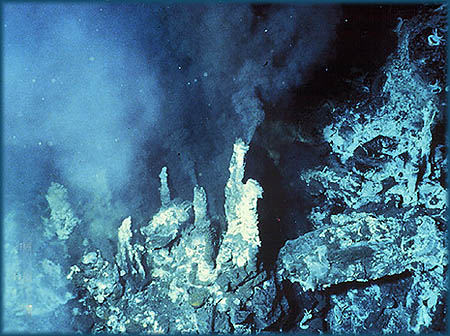·hydrothermal· ·vents·
Creatures of hydrothermal vents
·media·
·link·
What Are Hydrothermal Vents?
 Deep
on the ocean floor, millions of years ago, the plates of the Earth were
shifting, the Earth was changing. When this happened, cracks formed in
the crust and in the oceans, cold water rushed into these cracks. The
water traveled deeper and deeper, eventually finding the hot core of the
Earth. Now, as everyone knows, when things get hot, they expand. The water
then rushed out of the cracks in a plume of black smoke, thus creating
a "Hydrothermal Vent."
Deep
on the ocean floor, millions of years ago, the plates of the Earth were
shifting, the Earth was changing. When this happened, cracks formed in
the crust and in the oceans, cold water rushed into these cracks. The
water traveled deeper and deeper, eventually finding the hot core of the
Earth. Now, as everyone knows, when things get hot, they expand. The water
then rushed out of the cracks in a plume of black smoke, thus creating
a "Hydrothermal Vent."
A Hydrothermal Vent is equatable to a geyser, only found underwater.
Most smokers are found at great depths ranging from 700 meters to 3650
meters below sea level. The sea life at these depths  have
been found to be 10,000 to 100,000 times more dense than that of sea level
creatures. Eruptions of lava on the sea floor as it widens appear to form
deep cracks into which salt water flows. These crack in some cases run
more than a mile into the earths crust. These cracks evolve into a series
of passageways along which hot, mineral-rich salt water flows towards
the surface. The theory is that sea water enters in one place then makes
its way down the crack finally hitting the molten rock then heating tremendously
in turn then boiling back to the surface of the crack. The water in these
crack is alomost instantly super heated to temperatures of 350° C.
As this super heated water rushes up to the surface is mixes with the
cold bottom of the ocean water which is 2° C the once disolved minerals
condense and dump creating the chimney like smoke stacks. Black smokers
are named for the soot like apperarance of the minerals that they spew
forth out of the billowing chimneys that they create
have
been found to be 10,000 to 100,000 times more dense than that of sea level
creatures. Eruptions of lava on the sea floor as it widens appear to form
deep cracks into which salt water flows. These crack in some cases run
more than a mile into the earths crust. These cracks evolve into a series
of passageways along which hot, mineral-rich salt water flows towards
the surface. The theory is that sea water enters in one place then makes
its way down the crack finally hitting the molten rock then heating tremendously
in turn then boiling back to the surface of the crack. The water in these
crack is alomost instantly super heated to temperatures of 350° C.
As this super heated water rushes up to the surface is mixes with the
cold bottom of the ocean water which is 2° C the once disolved minerals
condense and dump creating the chimney like smoke stacks. Black smokers
are named for the soot like apperarance of the minerals that they spew
forth out of the billowing chimneys that they create
To date the largest black smoker found is located in 3650 meters of water on the eastern side of the Mid-Atlantic ridge, a few thousand miles directly east of Miami Florida. 160 ft high and 600 ft in diameter
Scientists now believe that these black smokers acount for 34% of the heat input of the global oceans and about 25% of the the globes total heat input. It is also thought that because of the massive dumps of minerals from these smokers they are what regulates the elemental composition of the sea water.
The chemicals that spew out of the vents include chlorine, sodium, magnesium, sulfur, calcium, potassium, bromine, iron, and carbon.
